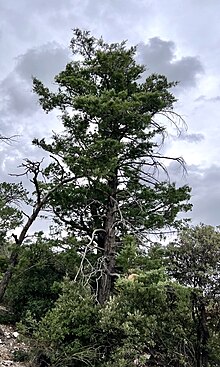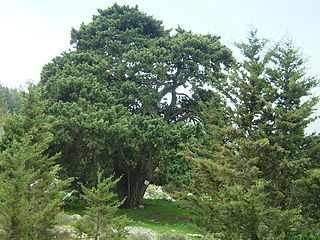
Cupressus is one of several genera of evergreen conifers within the family Cupressaceae that have the common name cypress; for the others, see cypress. It is considered a polyphyletic group. Based on genetic and morphological analysis, the genus Cupressus is found in the subfamily Cupressoideae. The common name "cypress" comes via the Old French cipres from the Latin cyparissus, which is the latinisation of the Greek κυπάρισσος (kypárissos).

Hesperocyparis macrocarpa also known as Cupressus macrocarpa, or the Monterey cypress is a coniferous tree, and is one of several species of cypress trees endemic to California.

Xanthocyparis is a genus of cypresses in the family Cupressaceae. As of August 2021, it has only one species, Xanthocyparis vietnamensis, native to Vietnam and southeast China. It is commonly known as the Vietnamese golden cypress. The Nootka cypress, Cupressus nootkatensis or Callitropsis nootkatensis, was also placed in the genus, but this has been rejected.

Hesperocyparis bakeri, previously known Cupressus bakeri, with the common names Baker cypress, Modoc cypress, or Siskiyou cypress, is a rare species of western cypress tree endemic to a small area across far northern California and extreme southwestern Oregon, in the western United States.
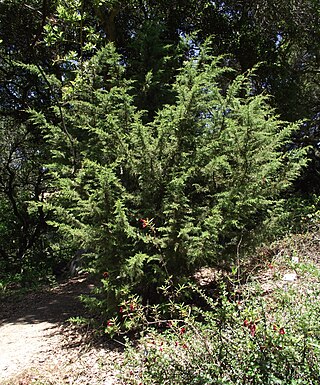
Hesperocyparis goveniana commonly known as Californian cypress and Gowen cypress, is a species of western cypress that is endemic to a small area of coastal California near Monterey. It was formerly classified as Cupressus goveniana.

Hesperocyparis pygmaea, the Mendocino cypress or pygmy cypress, is a taxon of disputed status in the western cypress genus. It is endemic to certain coastal terraces and coastal mountain ranges of Mendocino and Sonoma Counties in northwestern California. It is a variable tree, and closely related to Hesperocyparis abramsiana and Hesperocyparis goveniana, enough to sometimes be considered conspecific with them.

Hesperocyparis guadalupensis, commonly known as Guadalupe cypress, is a species of western cypress from Guadalupe Island in the Pacific Ocean off the western coast of Mexico's Baja Peninsula. It was previously known as Cupressus guadalupensis until 2009. It is a medium sized tree with fine green to blue-green foliage. In its native habitat it depends on water from the fogs that envelop the high northern half of the island. It became an endangered species due to feral goats living on Guadalupe Island that prevented new trees from growing for more than a century. In 2005 the goats were finally removed from its island home as part of an island restoration project. New trees are growing and other plants are beginning to recover though the future of the species is not yet assured. Guadalupe cypress is closely related to the vulnerable Tecate cypress which grows on the mainland in Baja California and southern California. It is used as an ornamental tree in Mediterranean climates, particularly in Europe, but has no significant human uses.

Monardella is a genus of approximately 40 species of annual and perennial plants native to western North America from British Columbia to northwestern Mexico. They are grown for their highly aromatic foliage, which in some species is used for herbal teas. The two-lipped, tubular flowers are formed in terminal clusters and are most usually red, pink, or purple.

The Santa Cruz cypress is a species of North American tree within the cypress family. The species is endemic to the Santa Cruz Mountains within the Santa Cruz and San Mateo counties of west-central California. The U.S. Fish and Wildlife Service listed the species on the Endangered Species Act in 1987 due to increasing threats from habitat loss and disruption of natural forest fire regimes. In 2016, the conservation status of the Santa Cruz cypress changed to Threatened. The cited reasoning was a decrease in threats against their habitat.

Hesperocyparis lusitanica, the Mexican cypress, cedar-of-Goa or Goa cedar, is a species of cypress native to Mexico and Central America. It has also been introduced to Belize, Costa Rica and Nicaragua, growing at 1,200–3,000 metres (3,900–9,800 ft) altitude.
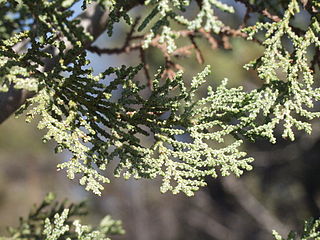
Hesperocyparis macnabiana is a species of western cypress in from California that was previously named Cupressus macnabiana.

Hesperocyparis sargentii is a species of conifer in the family Cupressaceae known by the common name Sargent's cypress. It is endemic to California, where it is known from Mendocino County southwards to Santa Barbara County. This taxon is limited to the Coast Range mountains. It grows in forests with other conifers, as well as chaparral and other local mountain habitat, usually in pure stands on serpentine soils. It generally grows 10 to 15 meters tall, but it is known to exceed 22 meters. On Carson Ridge in Marin County, as well as Hood Mountain in Sonoma County, the species comprises a pygmy forest of trees which do not attain heights greater than 240–360 cm due to high mineral concentrations in the serpentine soil.

Hesperocyparis forbesii, with the common names Tecate cypress or Forbes' cypress, is a nonflowering, seed bearing tree species of western cypress native to southwestern North America in California and Baja California. It was formerly known as Cupressus forbesii.

Hesperocyparis stephensonii is a species of western cypress known as the Cuyamaca cypress that is found only in two very small areas in Southern California and northwestern Baja California.

Hesperocyparis glabra, known as the Arizona smooth bark cypress or smooth Arizona cypress, is a conifer native to the American Southwest, with a range stretching over the canyons and slopes in a somewhat wide vicinity around Sedona, Arizona. It is distinguished from Hesperocyparis arizonica by its very smooth, non-furrowed bark which can appear in shades of pink, cherry, and grey.

Hesperocyparis nevadensis is a species of western cypress tree with the common name Paiute cypress native to a small area in the Sierra Nevada Mountains of California in the western United States. It was formerly known as Cupressus nevadensis.

Hesperocyparis is a genus of trees in the family Cupressaceae, containing North American species otherwise assigned to the genus Cupressus. They are found throughout western North America. Only a few species have wide ranges, with most being restricted-range endemics.
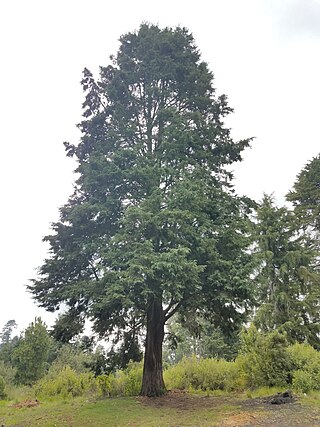
Hesperocyparis benthamii is a species of western cypress native to Mexico.
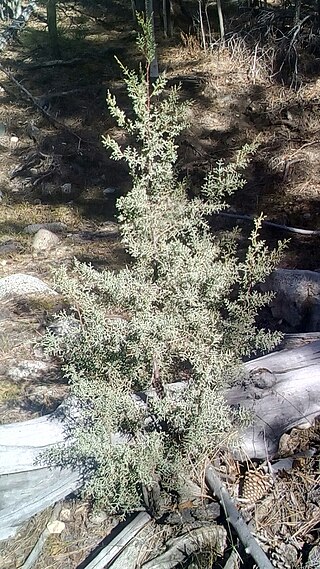
Hesperocyparis montana, commonly known as the San Pedro Mártir cypress or San Pedro cypress, is a species of conifer. It is a tree native to the Sierra de San Pedro Mártir of Baja California state in northwestern Mexico.

Hesperocyparis revealiana is a rare Mexican species of conifer in the cypress family, is endemic to a small area of the State of Baja California in northwestern Mexico.




